Residential Living at Burj Khalifa: A Unique Perspective

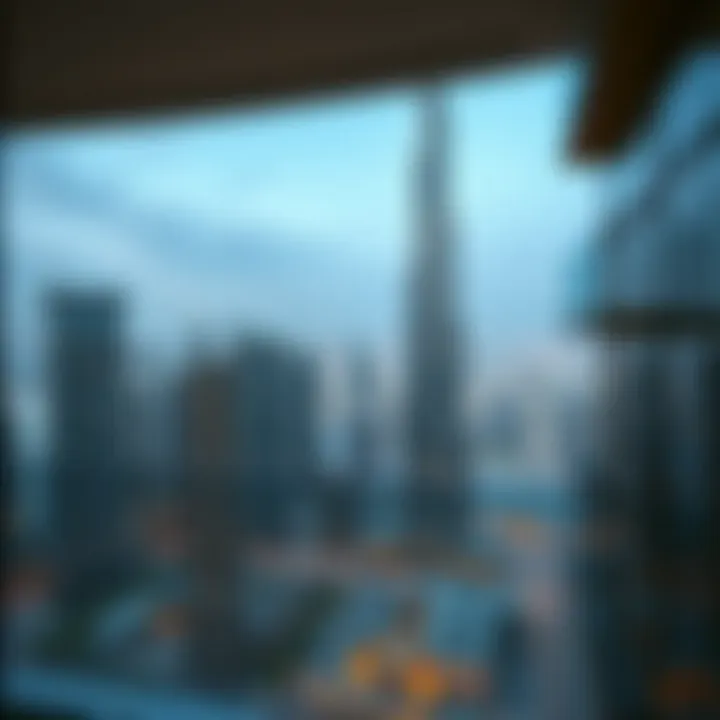
Intro
As one of the most recognizable structures on the planet, Burj Khalifa towers over Dubai, attracting countless visitors and residents alike. However, beyond its glittering façade and breathtaking height, there's an intriguing residential aspect that often slips under the radar. Within its 163 floors, Burj Khalifa houses an exclusive collection of luxurious flats—ranging from one to four bedrooms—that offer a unique living experience amid the hustle and bustle of the city.
This exploration delves into the nuances of life within this iconic monument. It takes a closer look at the architectural design, the amenities available to residents, and the broader socio-economic implications of residing in such a landmark. By peeling back the layers of luxury and prestige, we aim to provide a vivid picture of what it feels like to call this architectural marvel home.
This guide will appeal primarily to homeowners, visitors, planners, and architects, offering substantial insights into the magnificent world of residences within Burj Khalifa. We will investigate the stunning surroundings, community aspects, and the lifestyle choices available to those fortunate enough to live in this sky-high haven.
With each section, readers will gain an enriched understanding of the extraordinary lifestyle that comes with residing in one of the tallest buildings in the world.
Preface to Burj Khalifa's Residential Features
The Burj Khalifa, a gleaming icon on Dubai’s skyline, represents more than just modern architecture; it encompasses an entire lifestyle. This section aims to shine a light on the features that make its residential spaces distinct. Living in one of the world’s tallest buildings is not merely about height — it’s about experience, community, and amenities tailored to enhance daily life.
Overview of the Burj Khalifa
The Burj Khalifa stands tall at 828 meters, boasting over 160 floors that house a mix of commercial, hospitality, and residential spaces. Among them, approximately 900 luxurious apartments dominate the upper floors, offering breathtaking views of the city and the Arabian Gulf. But it’s not just about fabulous vistas; the design embodies opulence, intertwining cutting-edge technology with exceptional comfort. Each unit captures a harmonious blend of style and functionality. Let’s face it, living here is not just about having a roof over one's head; it’s about a lifestyle imbued with luxury and prestige.
Architectural wonders abound: the building’s unique Y-shaped floor plan optimizes the floor space and provides its residents the utmost privacy. Furthermore, this design not only makes a striking visual statement but also shows considerable foresight in energy conservation, a vital aspect in today's environmentally-conscious world.
Significance of Residential Spaces in Skyscrapers
Residential spaces in skyscrapers like the Burj Khalifa carry significant weight in urban planning and societal structure. They offer a solution to the relentless encroachment of urban populations, providing vertical communities in a tight footprint. Living in a compact urban environment is often a reality nowadays, and high-rise residences showcase how class and comfort can coexist.
Benefits abound when it comes to residing in a skyward community:
- Space Efficiency: High-rises demand less ground space, preserving valuable land for parks and public use.
- Community Engagement: These buildings create opportunities for social interaction among residents, fostering a sense of togetherness.
- Convenience: Many skyscrapers, including the Burj Khalifa, integrate essential amenities like grocery stores, fitness centers, and cafes within their premises, simplifying daily living.
“Residential spaces in the clouds do not just cater to the privileged; they represent a bold vision for future urban living.”
Thus, as we delve into the specifics of Burj Khalifa's residential offerings, it becomes clear that living here is distinct from traditional urban layouts. It’s a unique community experience steeped in luxury and modern conveniences. From breathtaking apartment designs to the myriad amenities designed to bolster lifestyle quality, the Burj Khalifa is not just a place to reside — it's an invitation to immerse oneself in the extraordinary.
Total Flats in Burj Khalifa
When considering the Burj Khalifa, it’s hard to overlook the remarkable number of residential units housed within its towering structure. The total flats in Burj Khalifa epitomize the blend of luxury and urban living in Dubai. Understanding the sheer scale and offerings of these apartments is essential for grasping the entirety of what the Burj Khalifa represents as a residential space.
The significance of the total residential units stretches beyond mere numbers; it reflects the demand for high-end living in one of the most iconic locations globally. The availability of these flats not only caters to an elite clientele but also aims to create a vibrant community within the skyscraper itself. Each flat is a part of an upscale lifestyle that offers breathtaking vistas and an unparalleled living experience, mirroring the extravagant image of Dubai.
Residential Units Breakdown
Within the Burj Khalifa, a blend of various apartment types contributes to its unique residential landscape. There are precisely 900 living units available, comprising an assortment of studio, one-bedroom, two-bedroom, and three-bedroom apartments. This diversity of offerings means that different lifestyles can be accommodated, from single professionals to families, each finding their niche within this architectural wonder.
Highlights of the units include not just their size but also their layout, which prioritizes comfort while maximizing views of the sprawling cityscape. Each floor blends creativity with functionality, ensuring residents enjoy not just a place to live but a whole experience.
Distinct Types of Apartments
Studio Apartments
Studio apartments in the Burj Khalifa stand out due to their compact yet clever design. These units are highly appealing to young professionals or individuals who prioritize simplicity and efficiency. The key characteristic of a studio in this skyscraper is its open layout, combining living, sleeping, and cooking areas into a single space.
The unique feature of these apartments is their expansive windows, allowing for ample natural light and offering stunning views of the Dubai skyline. While some may argue that the size can be restrictive, the benefits often outweigh the drawbacks for those embracing a minimalistic lifestyle.
One-Bedroom Apartments
The one-bedroom apartments provide an interesting middle ground, balancing space and intimacy. They are ideal for couples or professionals desiring a little extra room without breaking the bank. The defining trait of these apartments is their separate bedroom, which can offer a welcome retreat from an open living area.

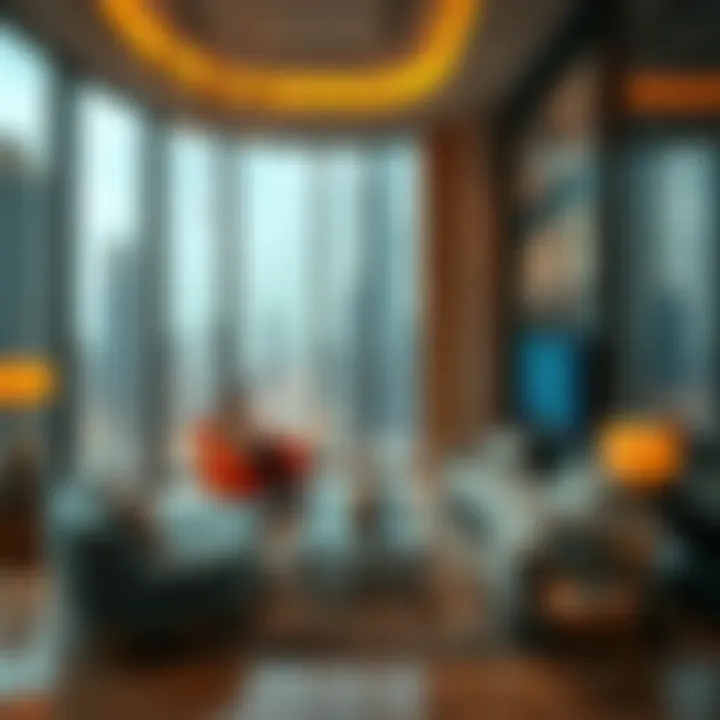
With their cleverly designed interiors, one-bedroom apartments promise both luxury and functionality. Residents enjoy a designated area for relaxation, which can enhance the overall experience of living in such a remarkable building.
Two-Bedroom Apartments
Two-bedroom apartments cater to a slightly larger demographic, being popular with small families or roommates. These units feature separate sleeping quarters, making them a practical choice for those needing more living space. The advantage of two-bedroom flats is their versatile layout, which can accommodate various living arrangements.
Moreover, they often come with additional amenities, such as an extra bathroom or larger kitchen space, increasing their allure. Such features help maintain a comfortable lifestyle while living in the sky.
Three-Bedroom Apartments
Finally, the three-bedroom apartments in the Burj Khalifa cater to families or those who frequently entertain guests. The spacious design is a significant draw, providing an abundance of room to move around. The standout aspect of these units is the expansive communal areas, which promote a family-friendly environment.
Offering extraordinary views, these apartments also often include premium appliances and luxurious finishes, embodying the height of sophistication. However, the trade-off often lies in the price point, as luxury comes with a heftier price tag.
Architectural Design Considerations
When one thinks of the Burj Khalifa, a pinnacle in modern architecture, the prominent idea revolves around its sheer height. Yet, digging deeper into its architectural design reveals a blend of aesthetics and functionality that significantly enhances residential life. These considerations play a critical role in how residents experience their homes within this remarkable tower.
Structural Innovations in the Burj Khalifa
The Burj Khalifa isn't merely about impressive verticality; it's a showcase of structural advancements that were tailored to confront the unique challenges posed by its lofty aspirations. With a height of 828 meters and 163 floors, the design had to ensure stability against wind forces, which are amplified at such altitudes. One of the most innovative aspects is the buttressed core.
This structure supports the building's weight while allowing for a unique floor layout. The three-lobed footprint adds not only to the aesthetic appeal but also provides maximum stability. This kind of engineering speaks volumes about how much thought went into ensuring residents feel secure within their homes, even when they're living hundreds of meters above the city's bustling streets.
Moreover, the incorporation of advanced materials, such as high-strength concrete, plays a pivotal role. The Burj Khalifa was specifically designed to withstand temperature fluctuations, quite common in the Dubai climate, optimizing comfort for its inhabitants.
With features like tuned mass dampers, which absorb vibrations, the Burj Khalifa offers a living experience that rivals the best urban lifestyles across the globe. These innovations not only underscore the ambitious vision behind this skyscraper but also manifest as tangible benefits for its residents.
Design Inspirations and Challenges
The Burj Khalifa’s design takes its cue from traditional Islamic architecture, echoing the Islamic gardens and minarets, which is significant in a city so rich in culture and history. Its form is said to represent the Hymenocallis flower; thus, the organic curves and elegance juxtapose the stark lines often associated with skyscrapers. This blend of modernity and tradition speaks directly to residents, giving them a sense of connection to the city’s heritage while living in a state-of-the-art environment.
However, the challenges during the design process were just as monumental as the aspirations. Balancing design inspiration with the harsh realities of engineering was no simple feat. The construction faced weather trials, including extreme heat and storms, pushing architects and engineers to rethink design strategies continually. The logistics of transporting materials to the higher floors also posed issues that needed crafting clever solutions.
Amenities Available for Residents
The Burj Khalifa is not just a towering symbol of architectural prowess; it is also a sanctuary for its residents, offering a lavish lifestyle that few other living spaces can rival. The amenities available within this iconic skyscraper play a vital role in shaping the overall living experience. From leisure facilities to modern support services, these amenities are designed to enhance comfort and foster a sense of community among residents.
On-Site Facilities
Swimming Pools
The swimming pools in Burj Khalifa represent more than just a place to cool off; they are a blend of luxury and leisure. These pools, located on higher floors, present stunning views of the city and the surrounding landscape, creating a serene paradise amidst the hustle and bustle of urban life. The key characteristic of these swimming pools is their infinity edge, which aligns perfectly with the horizon, making it visually captivating. Many residents find great joy in taking an evening dip while looking over the Dubai skyline.
However, it's important to consider that during peak hours, these facilities can become crowded. While the experience of swimming with a view is unmatched, the potential for limited personal space might detract from the tranquil atmosphere. Nonetheless, it’s a popular amenity, reflecting the high standard of living expected by those living in Burj Khalifa.
Fitness Centers
Fitness enthusiasts will find the fitness centers in Burj Khalifa to be well-equipped and thoughtfully designed. These centers include a range of modern gym equipment and dedicated spaces for various types of exercise, from cardio to strength training. The standout feature here is the panoramic windows, which let in natural light and provide magnificent views of the city while working out. This element makes the experience more uplifting and invigorating.
Apart from offering modern equipment, the fitness centers often organize personal training sessions or fitness classes, contributing to a healthier lifestyle for all residents. However, while these facilities provide excellent workout options, access during busy hours can be a challenge, and waiting for machines or space may occur. Still, they remain a key draw for a life focused on wellness.
Function Rooms
Function rooms in Burj Khalifa serve as versatile spaces that residents can use for various occasions, ranging from private gatherings to community events. These rooms are designed with elegance and practicality in mind, featuring state-of-the-art audiovisual equipment and flexible layouts. The unique aspect of function rooms is their ability to host a range of events—everything from a birthday party to a formal meeting—right in the heart of the city.
Notably, these spaces can foster community interactions, allowing residents to engage with one another and build relationships. However, booking these spaces may require advance planning due to high demand, especially during festive seasons or major occasions. Nonetheless, their presence adds a significant layer to the living experience, allowing for both personal and social gatherings.
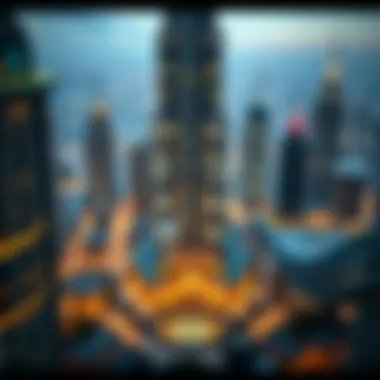
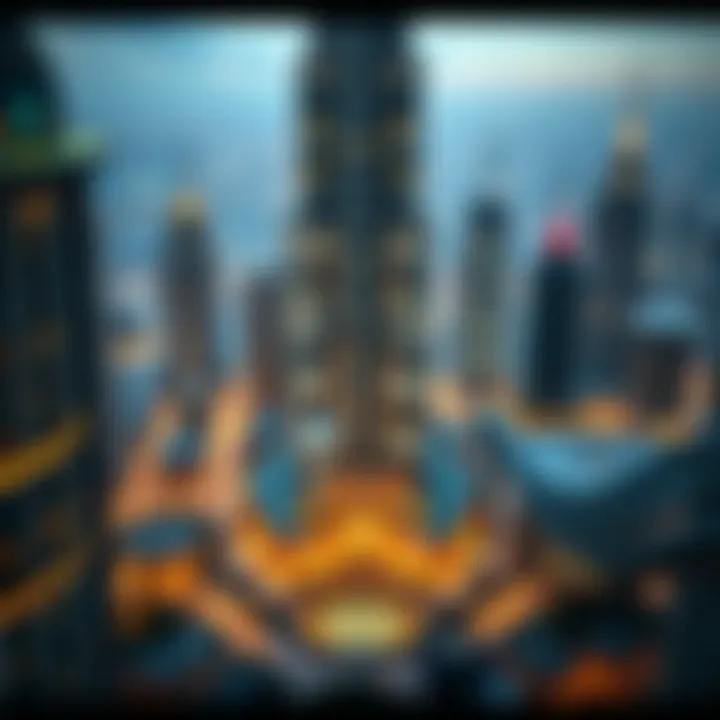
Services and Management
The management services associated with residing in Burj Khalifa are tailored to ensure that residents experience the highest level of convenience and comfort. From maintenance to concierge assistance, the management team is dedicated to addressing a variety of needs. This meticulous attention to service greatly enhances the quality of life for the inhabitants, making living in such a magnificent structure a truly enchanting experience.
Living Experience in the Burj Khalifa
The experience of living in the Burj Khalifa isn't just about occupying a space; it’s about being enveloped in a world that melds luxury with breathtaking views. This towering structure houses 900 apartments, creating a unique community that reflects Dubai’s cosmopolitan lifestyle. The ambiance here transcends mere residency; it shapes a way of life that few other locations can offer. In this section, we will delve into the nuances of community and social life as well as the privacy and security measures that make living in the Burj Khalifa not only attractive but also safe.
Community and Social Life
Living in such a high-profile building engenders a sense of belonging to something grander than oneself. The social networks formed here often revolve around shared experiences in this architectural marvel. Residents frequently engage in hosting social gatherings, fostering relationships with neighbors who come from diverse backgrounds. Many of these connections arise in shared amenities like the fitness centers and swimming pools, making it easier to interact and build friendships. Residents often find themselves in a melting pot of cultures with various traditions intermingling.
Moreover, there are exclusive events organized by the building's management, aimed specifically at residents. Such activities facilitate community bonding and offer opportunities to meet others living in the same vicinity. These events can include seasonal celebrations or workshops that cater to different interests, contributing to a vibrant social life within these heights.
Privacy and Security Measures
When considering the residential features of a skyscraper, privacy and safety are paramount. The Burj Khalifa shines brightly in this aspect. State-of-the-art technology, combined with discreet practices, ensures that residents go about their lives with peace of mind.
For starters, the building employs 24/7 security personnel who keep a vigilant watch over the premises. Residents have key card access, ensuring that only individuals who live in or have business in the tower can enter specific floors. The building also incorporates comprehensive surveillance systems that monitor common areas without being intrusive to residents.
Moreover, many apartments include their own security features, like double-locking systems, which can deter unwanted visitors. This attention to detail creates a reassuring environment for anyone eyeing a place to call home in the clouds.
"Living in the Burj Khalifa isn't just about luxury; it’s about being part of a secure and vibrant community that cherishes both privacy and connection."
With a well-rounded living experience marked by community engagement and unparalleled security measures, Burj Khalifa stands not only as a pinnacle of architectural mastery but as a high-rise that nurtures a lifestyle few can claim.
Economic Implications of Residential Properties
The residential aspect of Burj Khalifa extends beyond mere living spaces; it plays a significant role in the economic landscape of Dubai and its real estate market. The dynamics of residential properties within this towering icon impact various sectors including finance, tourism, and urban development. Given the investment potential and unique lifestyle offered, the exploration of these economic implications sheds light on the broader context of living in such a remarkable structure.
Investment Value of Flats
When considering the Burj Khalifa, the investment value of its flats cannot be overstated. Owning a piece of this architectural marvel is akin to holding a golden ticket in an exclusive lottery. The value of these residential units has appreciated notably since their inception, driven by demand from wealthy investors and affluent residents alike.
Factors contributing to this investment appeal include:
- Prestige: Living in the Burj Khalifa is a statement in itself. It carries an allure that few other properties can match.
- Prime Location: Dubai's strategic position as a global business hub enhances the desirability of the area. The accessibility to major amenities, airports, and business centers are a draw for many.
- Luxury Amenities: The on-site facilities add another layer of value, making these flats not just homes, but lifestyle destinations.
A study from Britannica highlights that luxury apartments tend to offer significant returns on investment, particularly in high-demand locations. This is evident in Burj Khalifa's continual market performance, which has proven robust even in fluctuating economic climates.
Rental Market Insights
The rental market surrounding Burj Khalifa deserves careful consideration, as it illustrates the intricate balance between supply and demand in Dubai's real estate sector. Rentals in skyscrapers often attract those who seek elite living without the commitment of ownership.
Key insights into the rental market include:
- High Demand: Due to its status and location, flats in Burj Khalifa maintain high occupancy rates, essentially guaranteeing landlords a consistent stream of income.
- Competitive Pricing: Although rental prices can be steep, the satisfaction and experience of living in such a unique space offset the costs for many tenants.
- Variety of Options: The diverse range of apartments provides potential renters with options that suit various preferences and budgets, enhancing the appeal of the rental market.
In a report by Reddit, community discussions highlight that tenants feel secure investing in rentals at Burj Khalifa due to the building's stringent security measures and maintenance standards.
In summary, the economic implications of residential properties in the Burj Khalifa span beyond individual investment perspectives. They encapsulate a lifestyle, community interactions, and contribute significantly to Dubai's evolving urban identity. Living in such a notable structure impacts the life of residents, providing them with not only a home but also a status symbol that adds value both personally and financially.
Comparative Analysis with Other Skyscrapers
In appreciating the residential features of the Burj Khalifa, it becomes essential to take a step back and see how it stands against its peers in the skyscraper world. Comparing this towering marvel with other skyscrapers not only highlights Burj Khalifa's unique attributes but also provides valuable insights into emerging trends in urban residential design. This comparison can enhance our understanding of living dynamics in high-rise structures and help potential residents and investors grasp what makes the Burj Khalifa a remarkable choice.

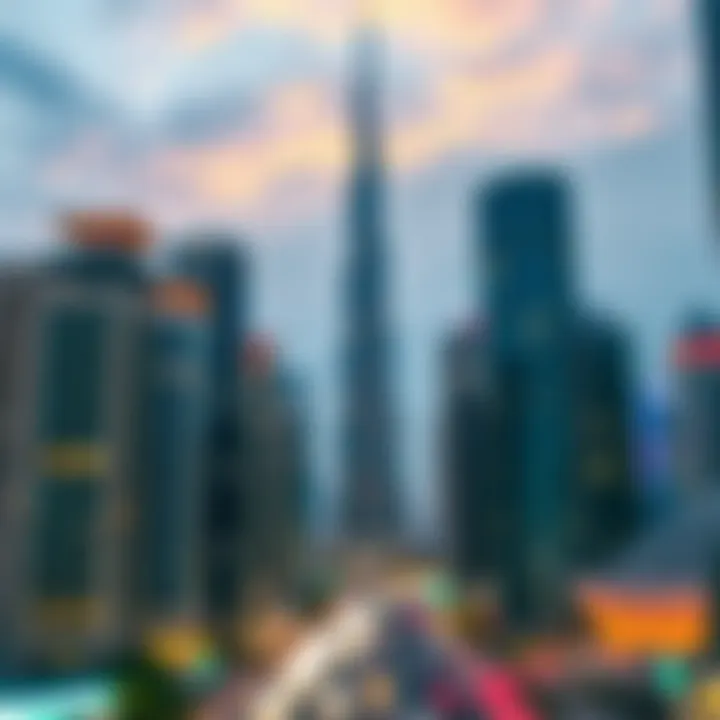
Global Comparisons
Residential Capacity of Global Towers
When examining the residential capacity of global towers, the Burj Khalifa boasts around 900 private residences. This number positions it among the more densely populated skyscrapers, which often offer a range of units from compact studios to expansive three-bedroom apartments. The appeal of such density is twofold: it allows for a vibrant community atmosphere and maximizes the use of vertical space in urban environments where land is at a premium.
One key characteristic that sets the Burj Khalifa apart is its combination of leisure and luxury within residential capacity. Many global towers focus predominantly on office spaces or mixed-use functionalities, but Burj Khalifa prioritizes living comfort. Notably, its unique design features such as wide terraces and panoramic views contribute to an enviable living experience. However, while residential capacity might seem advantageous, it can also lead to issues such as noise and congestion that may deter those seeking solitude in the clouds.
Living Conditions in Similar Structures
In assessing living conditions in similar structures, it’s apparent that the Burj Khalifa offers a distinctive living experience compared to other skyscrapers. For example, towers like One World Trade Center or Taipei 101 provide primarily commercial spaces, which can significantly affect the day-to-day life quality of residents. In contrast, the Burj's thoughtful design prioritizes resident privacy and comfort, with amenities crafted to enhance lifestyle rather than just provide shelter.
A unique feature distinguishing the Burj Khalifa is its blend of luxury and practicality. The living conditions here are bolstered by amenities such as swimming pools, gyms, and communal areas that foster social interaction. However, one could argue that such density can challenge one's personal space, leading to a feeling of compromise in the sanctity of home life.
Lessons from Architectural Best Practices
When we delve into architectural best practices illustrated by the Burj Khalifa, several pertinent lessons emerge. For instance, effective use of space and the integration of natural elements into high-rise designs can facilitate not just aesthetic appeal but also improve residents' well-being. The essence of these lessons encourages future skyscrapers to consider both external appearances and internal living conditions for occupants.
In summary, analyzing the Burj Khalifa alongside other skyscrapers reveals both its strengths and possible drawbacks, culminating in a richer understanding of living in such a high-profile structure. This analysis sheds light on aspects like residential capacity, living conditions, and emphasizes the importance of architectural innovation and social dynamics which ultimately contribute to successful urban living.
Future of Residential Living in Burj Khalifa
The future of residential living in the Burj Khalifa carries a weight of significance that extends beyond mere aesthetics. While much of the conversation surrounding this landmark revolves around its towering structure and lavish amenities, it is the potential evolution of this living space that truly warrants attention. As urban landscapes morph, the role of this iconic skyscraper within Dubai's ever-changing environment becomes increasingly critical. By pinpointing essential elements like sustainability, community, and the shifting demands of urban living, we can paint a more vivid picture of what the future holds for those who call Burj Khalifa home.
Sustainability Features
One of the foremost considerations in residential design today is sustainability. In an age where eco-conscious living is not just encouraged, but essential, the Burj Khalifa has a unique opportunity to piviot into a more sustainable model. Although the building itself was groundbreaking at the time of its construction, ongoing advancements in green technology present a chance for improvements that could resonate with residents long into the future.
- Energy Efficiency: Modern innovations in energy-efficient systems can be integrated into the existing structure, minimizing energy consumption. The use of smart thermostats and renewable energy sources can significantly impact energy bills and overall ecological footprint.
- Water Conservation: Innovations like rainwater harvesting or greywater recycling could be utilized to mitigate water wastage, promoting a lifestyle that aligns with environmental sustainability.
- Community Gardens: These could not only beautify the residential experience but also encourage neighborly interaction, fostering a sense of community while promoting food security.
Embracing sustainability features could make living in Burj Khalifa not only luxurious but also ethically responsible, thereby attracting a generation of residents who value environmental stewardship.
Evolving Urban Landscape of Dubai
As Dubai confidently strides into a new era, the urban landscape is continuously shifting. This metamorphosis influences the residential aspects of the Burj Khalifa in profound ways. The city is not just a backdrop for this skyscraper; it is a living entity that evolves, impacting residents daily.
- Integration with Smart City Initiatives: Dubai's push toward becoming a smart city means that buildings like Burj Khalifa are no longer isolated landmarks but part of a broader network of technologically integrated urban spaces. Businesses and services will increasingly leverage technology to provide residents with seamless living experiences.
- Transport Evolution: Improved public transport systems, such as additional metro lines, could change the way residents perceive commuting. If Burj Khalifa is well-connected, it adds to the desirability of living there.
- Cultural Shifts: As the city embraces a diverse population, the expectations of residents will change. The need for various cultural amenities, community spaces, and social events will shape the lifestyle within the Burj Khalifa.
A keen understanding of these shifting dynamics will prepare homeowners for the future and attract visitors eager to experience living in one of the most recognized buildings in the world.
"To understand the future of residential living in Burj Khalifa is to grasp how urban development and sustainable practices can coalesce for a more profound living experience."
Through these insights, we see that the future of residential living in Burj Khalifa is not a stagnant entity but a canvas for continuous improvement and adaptation. As both sustainability features and the evolving urban landscape of Dubai shape the narrative, residents find themselves at the heart of an ever-changing lifestyle dictated by their environment and the choices available to them.
Closure
The conclusion of this article brings to light the significance of the residential features of the Burj Khalifa, offering insight into how these unique aspects contribute to life within and around this towering marvel. The Burj Khalifa is more than just a striking architectural feat; it embodies a lifestyle and an experience that is characterized by luxury, community, and unique amenities designed to elevate the standard of living for its residents.
In summary, we’ve explored various elements throughout the article, such as the diverse types of apartments available, the superior amenities tailored for comfort and convenience, and the economic factors that influence the residential market in the Burj Khalifa. Each of these points plays a crucial role in shaping the perception of living in one of the world’s tallest buildings. From swimming pools perched high above the city to exclusive fitness centers, every facet of the living experience is meticulously crafted.
Moreover, the insights into community dynamics within such a vertical living space reveal how social interactions develop differently compared to traditional housing. The blend of privacy with communal amenities fosters a unique residential identity, making living in the Burj Khalifa not just about having a home but being part of an extraordinary community.
Summary of Key Points
- Total Residential Units: The Burj Khalifa houses about 900 luxurious apartments ranging from studios to spacious three-bedroom units.
- Amenities: Residents enjoy access to high-end facilities, including several swimming pools, a top-notch fitness center, and event spaces that cater to social gatherings.
- Investment Value: The property represents a high-value investment despite the challenges of market fluctuations, appealing to homeowners and investors alike.
- Unique Living Environment: The experience of living in such an iconic structure is unlike any other, offering panoramic views and an exclusive lifestyle.
Final Thoughts on Residential Life in Burj Khalifa
Living at such heights is not merely about physical elevation but encapsulates an elevated lifestyle with distinct social and economic implications. The Burj Khalifa defines the skyline of Dubai, but it also redefines what it means to call a place home.
Being part of this unique residential space means more than just luxurious living; it involves participating in an interactive social environment fostered by shared experiences among residents. As Dubai continues to expand and evolve, so too will the living experience within the Burj Khalifa. This symbolizes a microcosm of future urban living, blending ecological considerations with innovative design and a sense of community.
The insights gained from exploring the residential aspects of this iconic skyscraper leave one pondering not only the structures we build but also the lives we lead within them.















